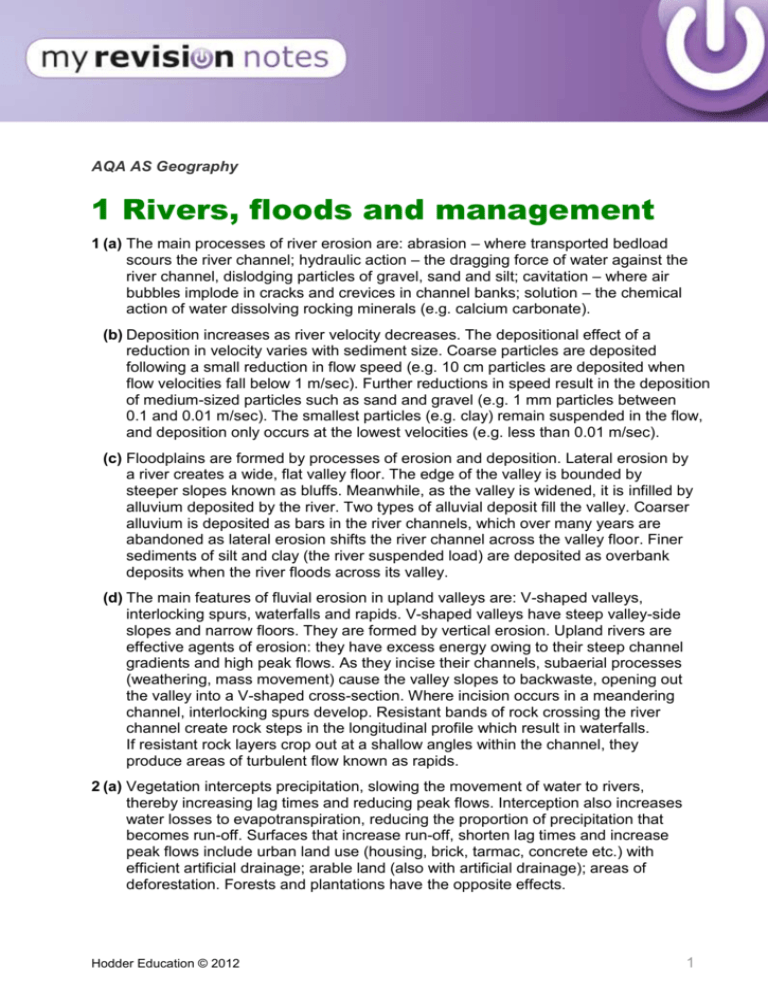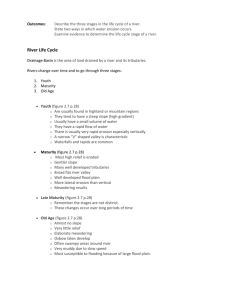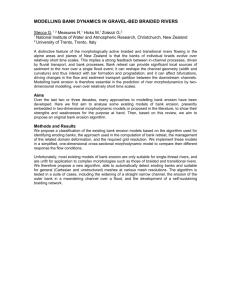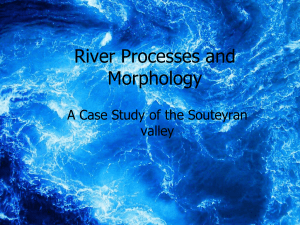Exam practice answers 1
advertisement

AQA AS Geography 1 Rivers, floods and management 1 (a) The main processes of river erosion are: abrasion – where transported bedload scours the river channel; hydraulic action – the dragging force of water against the river channel, dislodging particles of gravel, sand and silt; cavitation – where air bubbles implode in cracks and crevices in channel banks; solution – the chemical action of water dissolving rocking minerals (e.g. calcium carbonate). (b) Deposition increases as river velocity decreases. The depositional effect of a reduction in velocity varies with sediment size. Coarse particles are deposited following a small reduction in flow speed (e.g. 10 cm particles are deposited when flow velocities fall below 1 m/sec). Further reductions in speed result in the deposition of medium-sized particles such as sand and gravel (e.g. 1 mm particles between 0.1 and 0.01 m/sec). The smallest particles (e.g. clay) remain suspended in the flow, and deposition only occurs at the lowest velocities (e.g. less than 0.01 m/sec). (c) Floodplains are formed by processes of erosion and deposition. Lateral erosion by a river creates a wide, flat valley floor. The edge of the valley is bounded by steeper slopes known as bluffs. Meanwhile, as the valley is widened, it is infilled by alluvium deposited by the river. Two types of alluvial deposit fill the valley. Coarser alluvium is deposited as bars in the river channels, which over many years are abandoned as lateral erosion shifts the river channel across the valley floor. Finer sediments of silt and clay (the river suspended load) are deposited as overbank deposits when the river floods across its valley. (d) The main features of fluvial erosion in upland valleys are: V-shaped valleys, interlocking spurs, waterfalls and rapids. V-shaped valleys have steep valley-side slopes and narrow floors. They are formed by vertical erosion. Upland rivers are effective agents of erosion: they have excess energy owing to their steep channel gradients and high peak flows. As they incise their channels, subaerial processes (weathering, mass movement) cause the valley slopes to backwaste, opening out the valley into a V-shaped cross-section. Where incision occurs in a meandering channel, interlocking spurs develop. Resistant bands of rock crossing the river channel create rock steps in the longitudinal profile which result in waterfalls. If resistant rock layers crop out at a shallow angles within the channel, they produce areas of turbulent flow known as rapids. 2 (a) Vegetation intercepts precipitation, slowing the movement of water to rivers, thereby increasing lag times and reducing peak flows. Interception also increases water losses to evapotranspiration, reducing the proportion of precipitation that becomes run-off. Surfaces that increase run-off, shorten lag times and increase peak flows include urban land use (housing, brick, tarmac, concrete etc.) with efficient artificial drainage; arable land (also with artificial drainage); areas of deforestation. Forests and plantations have the opposite effects. Hodder Education © 2012 1 (b) The main pathways for water movement in drainage basins are: precipitation, evaporation, transpiration, overland flow, throughflow and groundwater flow. Overland flow is responsible for the rapid transfer of rainwater to rivers and induces short lag times, and high peak discharge. Rainwater which is transferred as throughflow may take several days to reach rivers. With longer lag times, this has less impact on discharge than overland flow. Groundwater flow delivers water to rivers that may have fallen as precipitation several months (or years) earlier. This type of flow regulates discharge: even periods of heavy precipitation have little effect on flow in rivers fed by groundwater (e.g. rivers draining chalk catchments). Evapotranspiration peaks in the summer months. High water losses at this time is the main reason why discharge and river flows fall to a minimum in the summer. (c) Bankfull is the maximum volume of water the river channel can contain. Any increase in discharge beyond bankfull leads to flooding. Rivers at bankfull have the greatest energy. This is due to (a) the large volume of water, (b) the high flow velocity, and (c) channel efficiency (i.e. the ratio of channel cross-sectional area to wetted perimeter) with minimum energy lost to friction. High energy levels at bankfull enable rivers to transport large amounts of sediment as bedload and suspended load, and erode their channels through abrasion, hydraulic action and cavitation. Most erosional and transportational activity by rivers takes place on just one or two occasions a year when bankfull discharge occurs. The result of these processes is erosional landforms (e.g. cut banks, valley slope collapse) and depositional landforms (e.g. alluvial channel bars). (d) Soft engineering river management strategies include land use change (e.g. reforestation of headwater catchments), floodplain management, flood warnings and flood insurance. These strategies are more sustainable (environmentally and economically) than hard engineering and have less impact on the environment. Reforestation and floodplain management often work with natural processes by reducing run-off and increasing water storage. Soft engineering strategies also have disadvantages: it may be difficult to get agreement from diverse landowners on policies such as reforestation and the abandonment of artificial land drainage. Given the huge investment in infrastructure on floodplains, it may be impossible to effect changes in land use. Flood insurance for households may be prohibitively expensive, especially as flood risks are likely to increase in future in response to climate change. Hodder Education © 2012 2









